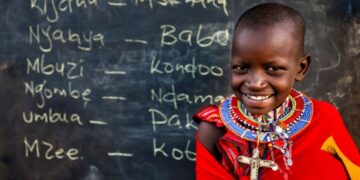Benin Republic is a West African country that has a lot of distinctive features, such as its key-shaped map, rich cultural history, and diverse natural environment. The Pendjari and W National Parks, Slave Routes, and Cotonou Fetish Market are just a few of the stunning tourism destinations the nation is known for.
More so, this country is the first successful nation in Africa to have transitioned from a dictatorship to a democracy. Eager to know more? Here are ten facts about Benin that will provide you with a good overview of this country.
1. Every 10th January is Marked as Voodoo Festival Day in Benin
As a cradle of Voodoo, Benin celebrates the Voodoo festival every January 10 in the city of Ouidah. The festival is recognized by the government as a public holiday and is commemorated with respect to the deities, spirits, and ancestors.
During the festival, ceremonies such as ritual sacrifices, offering of food and drinks, dancing, and heating of drums. Devotees are dressed in colorful costumes that represent the gods.
Aside from this celebration of Voodoo, Benin also has a fetish market in Cotonou where it sells anything associated with the practice. Traditional medicines and voodoo effigies such as dried animal parts, the bark of trees, and carved wood are sold there for different Voodoo practices.
2. The Female Warriors in Black Panther Were Inspired By the Agadogie of Benin
The female warriors of Dahomey known as the Dahomey Amazons or Agojie inspired the female fighters in the film Black Panther (2018).
The Dahomey Amazons were a group of women who served as warriors in the Kingdom of Dahomey, which existed in present-day Benin from the 17th to the late 19th century. They were known for their combat skills and were often used as bodyguards for the king.
The portrayal of strong and powerful women in Black Panther, particularly the all-female Dora Milaje warriors, has been linked to the Dahomey Amazons. The film’s director, Ryan Coogler, has acknowledged the influence of African history and culture on the film, and they drew inspiration from the Dahomey Amazons when creating the Dora Milaje warrior.
3. West Africa’s Floating Salt Village is in Benin
Djebaji is a Floating Salt village in Benin and it’s one of a kind. Most of the local salt in Benin is produced in this village and is sold to the people. The Inhabitants of Djebaji live on water and have their kitchens on the water where they produce salt. They use the water from the lagoon and make salt with it.
The salt village is about 5 hectares having over 100 kitchens on water that produces salt in Benin.
4. It Has The Second-highest population of The Yoruba Group in Africa
Benin is the second nation in Africa and the world at large to house the highest population of the Yoruba ethnic group. As a Niger-Volta language, the Yoruba is found in West African countries such as Nigeria, Togo, Sierra Leone, Cote d’Ivoire, Gambia, and Benin.
In Benin, the Yoruba language is one of the major ethnic indigenous languages constituting over 10 percent of Benin’s population the nation aside from the Fon, Adja, and Bariba groups. The Yoruba communities have been thriving and have over 30 Obas ruling their communities in the country.
5. The Longest Graffiti Wall in Africa is Situated in Benin
Cotonou is home to Africa’s largest graffiti wall which has a length of 940 meters. The Graffiti was made by 40 professional artists in the continent and all over the wall who participated in the 7th edition of the Graffiti Effect Festival.
The art has been appreciated and accepted by the public and the authorities for honoring their countries’ historical legacy which has helped boost the nation’s tourism in Africa.
6. Snake Symbolizes Good Luck in Benin
Benin is known for revering serpents just like the Indians who are known for worshiping cattle. When one crosses paths with the creature, it is seen as a sign of good fortune.
Also, snakes in Benin symbolize Peace, Prosperity, and Wisdom. Their theology holds that there is a god known as Dan, a rainbow snake, who acts as a bridge between the spirits and the living.
The inhabitants of Ouidah hold the belief that when their king sought refuge in the forest during the 17th-century war, Pythons appeared and saved him from being captured. Currently, in Ouidah there is a Temple of Snakes where the species of Python known as Royal Python are kept in the temple. Also, it has been reported that the temple is home to over 60 Pythons.
It’s interesting to note these creatures are allowed to go out at night and they mostly end up in people’s homes where they are treated like guests before being brought back to the temple.
See Also: Every African Country, Capital, How It Got Its Name, Most Spoken Language
7. It Has The Largest Remains Of Lions in West Africa
Since the 18th century, the number of lions has severely decreased to just a few hundred in West Africa. At this time, Benin is the country with the greatest number of lions, with over 100 lions that reside in Benin’s Pendjari National Park.
Prior to their extinction, the creatures preyed on livestock outside the national park, which prompted retaliatory killings by the locals in the area. Also, The University of Michigan conducted research to determine the cause of the species extinction; according to their research, the lions lack access to water, good habitat, and an abundant variety of prey that forces them out of their territory resulting in their death.
8. Benin Houses Part of The “Benin Bronze” Collections in Africa
Aside from the Giant of Africa, Benin is said to abode some of the Benin Bronzes on the continent. The Benin Bronze is a collection of bronze sculptors that were made to represent royalty and Vodun figures. The artifacts were often used during ceremonial events and served as currency and diplomatic gifts.
However, most of the bronzes were taken by colonial masters during their rule. Artifacts like King Ghezo’s wooden throne, bocios, and others were held in Paris. Nevertheless, the sculptors were returned and some were made by local artists and are now in the Musee Honme in Porto Novo. The sculptures are a testament to the rich cultural heritage of West Africa and will continue to be admired by many.
9. Locals Have a Special Name For Foreigners Most Especially The Whites
In Benin, whites and other foreigners are referred to as “Yovo”. The word is derived from the Fon language which means a person with white skin or a foreigner. Moreover, they also have a song about Yovos that goes this way
Yovo, Yovo, bon soir
Ca va? Ca va, merci
et chez vous?
The song is interpreted to mean “foreigner, how are you? I am fine, and you?’ it is repeated over and over to form the song. Amazingly, this song is taught in schools to students as a way to interact with foreigners. It’s sung by adults and children of the country but is often perceived by these visitors as annoying because they are trying to make gest of a person. If you find yourself in Benin and the Yovo song is been sung see it as a friendly approach from the people.
10. Scarf on a Lady’s Head Signifies Unavailability in Benin
When a lady or girl is seen with a scarf in Benin it simply, means she is unavailable for any advances. Women who are seen with head ties are usually old women and married women. As such, respect is given to ladies seen with scarves on the street of Benin. However, ladies try to tie their heads to avoid unnecessary attention and to avoid harassment on the streets.
Additionally, dressing decently is of utmost priority in the country. In this regard, ladies are expected to avoid wearing anything below the knees and tops with exposed shoulders and hands because they draw attention on the streets of Benin.




















